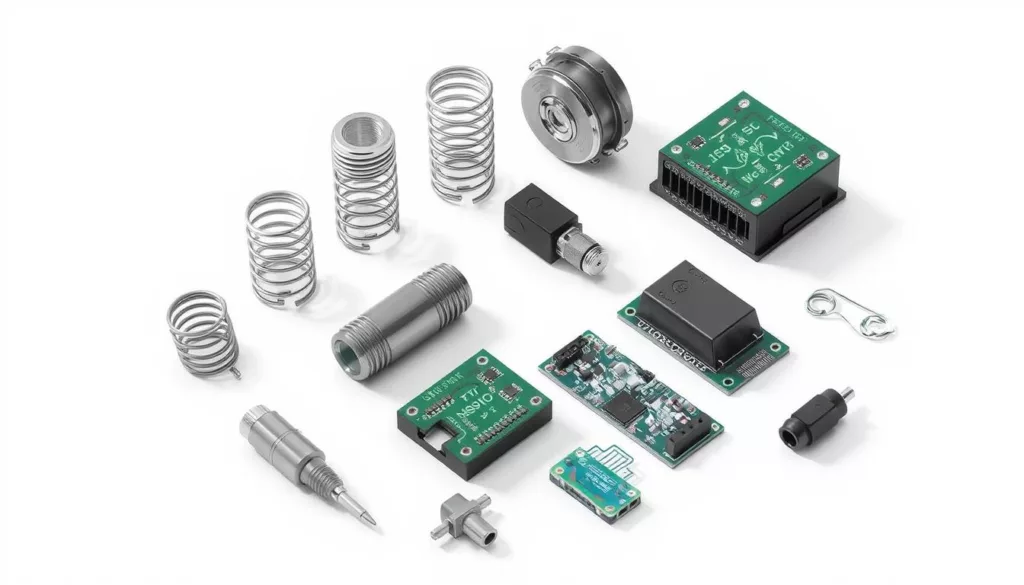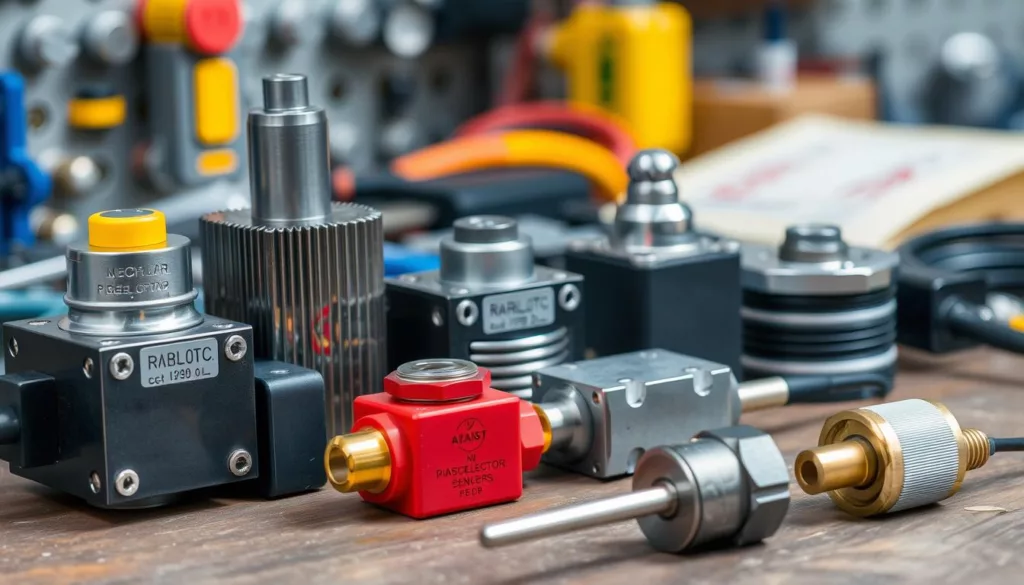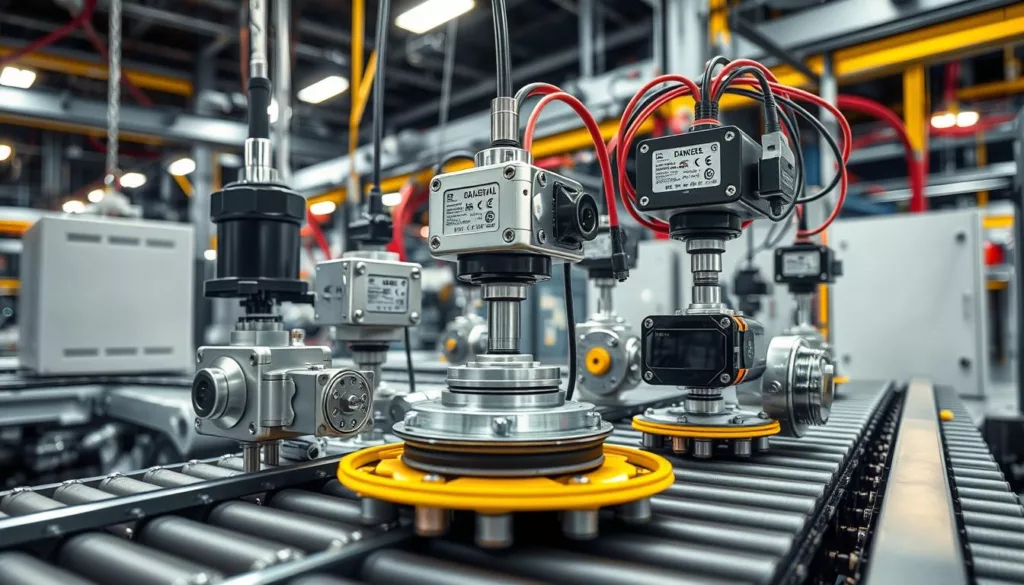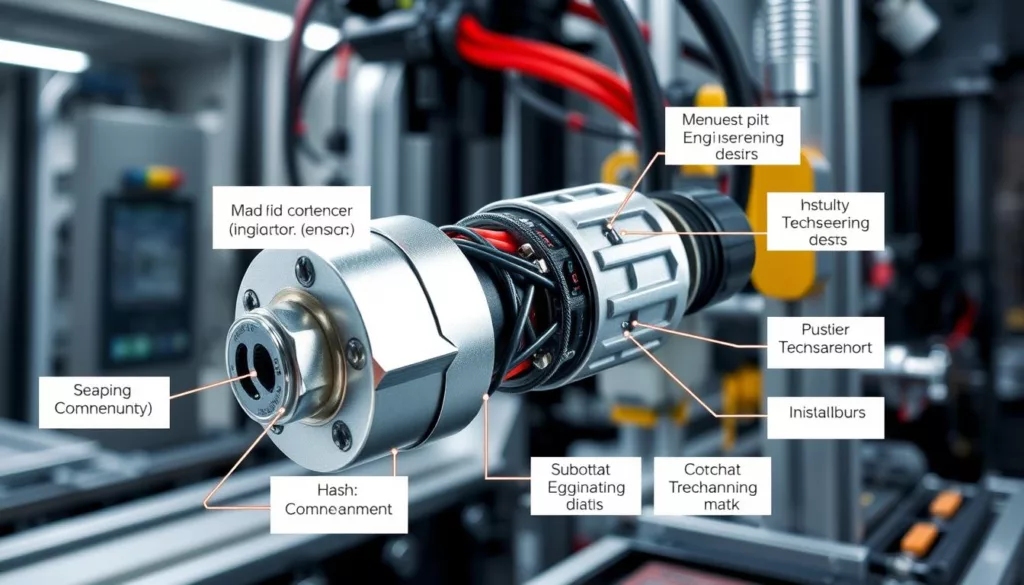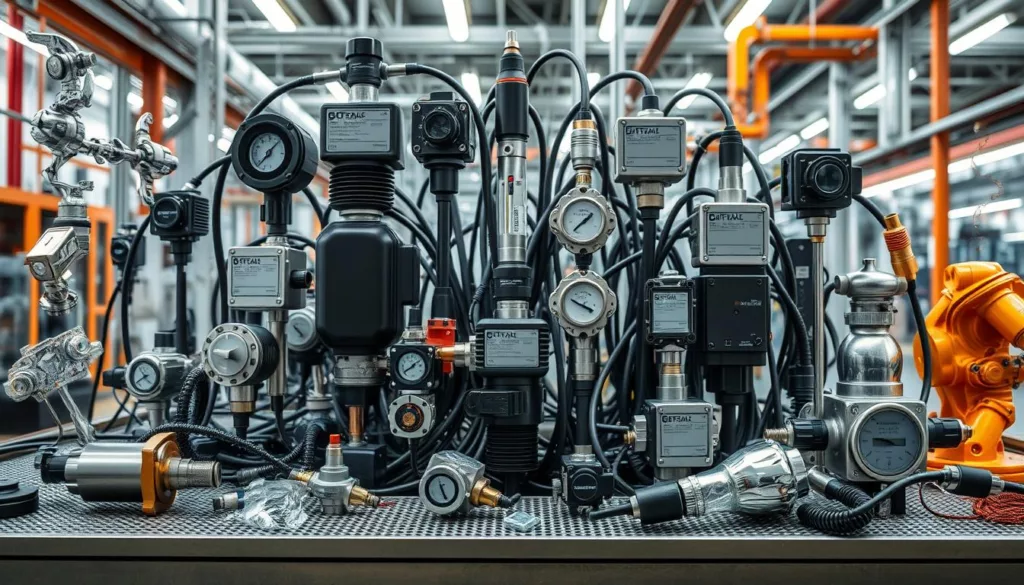In today’s fast-changing industrial world, it’s key to measure and control web tension well. This is vital for better production, quality, and equipment use. Tension sensors are essential in modern automation, giving the data needed for top process control. This guide will help you pick the right tension sensor for your needs.
Choosing the right tension sensor means knowing about tension measurement basics, sensor types, and what your application needs. Look at the sensor’s range, accuracy, speed, and how it handles the environment. This ensures your tension sensor works well, accurately, and lasts long in your system.
Key Takeaways
- Understand the basic principles of tension measurement and the role of tension sensors in industrial process control.
- Familiarize yourself with the different types of tension sensors available in the market, including their unique capabilities and applications.
- Identify the critical application-specific requirements, environmental considerations, and performance specifications to guide your selection of the right tension sensor.
- Explore the differences between load cells and dancer rollers, and determine the optimal choice for your automation system.
- Understand the key technical parameters, such as measurement range, accuracy, response time, and signal output options, that influence sensor performance.
Understanding Tension Sensors in Modern Automation
Tension sensors are key in many industrial systems. They help keep product quality high and processes efficient. These devices measure force and torque to control tension in many fields, like web handling and textile making.
Basic Principles of Tension Measurement
Load cells and dancer rollers use transducers to turn mechanical forces into electrical signals. They measure tension or pulling force on materials. This data helps control systems optimize processes and ensure quality.
Role in Industrial Process Control
In automated factories, sensors are vital for keeping tension right. They manage web material speed and tension, ensuring quality and reducing waste. These sensors also guide industrial controls, making machines work better and faster.
Key Components and Functions
Tension measurement systems have a few main parts:
- Transducer: Turns mechanical force into an electrical signal.
- Load cells or dancer rollers: Measure tension in materials.
- Signal conditioning and processing circuitry: Makes the signal ready for use.
- Data acquisition and control systems: Use the sensor data for real-time adjustments.
Knowing how tension sensors work helps professionals improve efficiency and quality. This knowledge boosts competitiveness in their markets.
Types of Tension Sensors Available in Today’s Market
In the world of industrial automation, tension sensors are key for precise control. They help with load monitoring, tension transducers, and precision measurement. The market has many tension sensor options for different needs. Let’s look at some common types.
Load Cells
Load cells are very common in the industry. They use strain gauges to measure force or tension. Known for their precision measurement, they’re often chosen for accurate tension control.
Strain Gauge Sensors
Strain gauge sensors change electrical resistance with tension or compression. They’re sensitive and give real-time load monitoring data. This makes them good for many industrial processes needing precise tension transducers.
Dancer Rollers
Dancer rollers use a pivoting roller to detect and measure tension. They’re great for web-handling like printing, packaging, and textiles. They help keep tension transducers consistent and improve process efficiency.
Knowing about each tension sensor type helps professionals choose the right one. This ensures the best load monitoring and precision measurement in their operations.
Choosing the Right Tension Sensor for Automation
Choosing the right tension sensor for your automation needs is important. You need to think about several key factors. These include the application, environment, and performance specifications.
Application-Specific Requirements
First, you need to know what your application needs. Think about the process, materials, and tension levels required. This helps you find the right sensor for your specific needs.
Environmental Considerations
The environment where the sensor will be used is also important. Things like temperature, humidity, and chemicals can affect its performance. Make sure the sensor can handle your environment’s challenges.
Performance Specifications
Look at the sensor’s performance specs too. This includes the measurement range, accuracy, response time, and output options. These specs help ensure the sensor works well with your system.
| Specification | Importance | Considerations |
|---|---|---|
| Measurement Range | Ensures the sensor can accurately measure the required tension levels | Select a range that covers the expected tension values in your application |
| Accuracy | Provides reliable data for precise process control and optimization | Determine the acceptable level of accuracy based on your application requirements |
| Response Time | Allows for rapid detection and adjustment of tension changes | Choose a sensor with a response time that matches the dynamics of your process |
| Signal Output | Ensures seamless integration with your automation system | Select the appropriate output type, such as analog, digital, or fieldbus, based on your control system’s requirements |
By considering these factors, you can find the perfect tension sensor. It will improve your process control and add value to your operation.
Load Cells vs. Dancer Rollers: Making the Right Choice
When it comes to automation sensors, load cells and dancer rollers are key. They help make sure industrial processes run smoothly and efficiently. Knowing what each can do helps you pick the best one for your needs.
Load Cells: Precision and Versatility
Load cells are super accurate. They measure force or weight, perfect for precise tension control. They can handle loads from light to heavy, giving real-time data for better product quality and efficiency.
Dancer Rollers: Dynamic Tension Tracking
Dancer rollers track tension changes in web-based processes like paper or film. They use a roller’s movement to adjust tension quickly. They’re great for fast, continuous tension monitoring.
| Feature | Load Cells | Dancer Rollers |
|---|---|---|
| Measurement Principle | Strain-based | Displacement-based |
| Measurement Range | Wide, customizable | Limited by roller size and suspension |
| Precision | High, suitable for critical applications | Moderate, suitable for general web handling |
| Response Time | Slower, suited for static or slowly changing tension | Faster, suited for dynamic tension fluctuations |
| Maintenance | Minimal, with periodic calibration | Regular maintenance required for roller bearings |
When picking between load cells and dancer rollers, think about your needs. Load cells are great for precise control, while dancer rollers are better for web-based processes. Knowing your needs helps choose the right tension sensor.
“Choosing the right tension sensor for your automation system is key. It keeps product quality high, production efficient, and your processes reliable.”
Key Specifications and Technical Parameters
Choosing the right tension sensor for your industrial needs is key. You need to know the technical parameters that affect its performance. These specs determine the sensor’s precision, reliability, and fit for your application.
Measurement Range and Accuracy
The sensor’s measurement range and accuracy are vital. The range shows the tension values it can detect. Accuracy tells you how well it measures those values. For industrial controls, a precise tension sensor is essential.
Response Time and Sampling Rate
The sensor’s response time and sampling rate matter too. Response time is how fast it detects tension changes. Sampling rate is how often it measures. These are critical for fast-changing applications like web processing.
Signal Output Options
Tension sensors come with different signal outputs. You can choose analog or digital formats. The right output depends on your system’s needs and how you’ll use the tension data. This ensures smooth integration and reliable data.
| Specification | Description | Example Values |
|---|---|---|
| Measurement Range | The minimum and maximum tension values the sensor can detect | 0-100 N, 0-500 lbf |
| Accuracy | The degree of precision in the tension measurements | ±0.1%, ±0.5% |
| Response Time | The time required for the sensor to detect and react to tension changes | 1 ms, 5 ms |
| Sampling Rate | The frequency at which the sensor takes measurements | 1 kHz, 2.5 kHz |
| Signal Output | The format of the tension data transmitted by the sensor | 0-10 VDC, 4-20 mA, RS-485, DeviceNet |
Knowing these technical parameters is vital for picking the right precision measurement solution. By examining these specs, you can find a tension sensor that meets your automation system’s needs.
Environmental Factors Affecting Sensor Performance
When picking automation sensors for industrial controls and load monitoring, think about how the environment affects them. At XJCSENSOR, we know precision is key. Our experts help you find the right sensors for your needs.
Things like temperature changes, humidity, vibrations, and electromagnetic interference (EMI) can really impact sensor performance. Choosing sensors made for your environment ensures they work well. This helps avoid system failures and keeps things running smoothly.
Temperature and Humidity Considerations
Extreme temperatures can mess with sensor accuracy and speed. Our high-precision force sensors handle tough temperatures. High humidity can also harm sensors, so it’s important to pick weatherproof and corrosion-resistant ones.
Vibration and EMI Resilience
In busy industrial settings, vibrations and EMI can mess with sensor signals. Sensors that can handle these issues are key for reliable load monitoring and controls.
| Environmental Factor | Potential Impact on Sensor Performance | XJCSENSOR Solutions |
|---|---|---|
| Temperature | Inaccurate readings, slower response times | Sensors with thermal compensation features |
| Humidity | Sensor degradation, corrosion, and reduced reliability | Weatherproof and corrosion-resistant sensor designs |
| Vibration | Disruption of sensor signals, introduced errors | Sensors with advanced vibration-dampening capabilities |
| EMI | Interference with sensor signals, inaccurate readings | Sensors with robust shielding and EMI protection |
Choosing sensors that can handle your environment’s challenges ensures reliable performance. This boosts your industrial controls and load monitoring systems’ efficiency and productivity.
Integration Considerations for Automation Systems
When adding automation sensors to your web tension control systems, think about a few important things. You need to make sure they talk to each other well, are mounted right, and calibrated correctly. These steps help your tension sensors work better and last longer.
Communication Protocols
It’s key that your automation sensors can talk to your industrial controls. They should work with common protocols like Modbus, Profibus, and EtherNet/IP. This makes it easy for them to fit into your system.
Mounting Requirements
- Choose the right way to mount your sensor, whether it’s inline or with a dancer roller system.
- Make sure the sensor is fixed well to handle the environment, like vibrations and temperature changes.
- Keep some space around the sensor for easy maintenance and fixing.
Calibration Procedures
Calibration is key to keep your web tension control system accurate. Use the steps the maker suggests and check against standards to keep your tension measurements right.
| Calibration Interval | Recommended Practices |
|---|---|
| Quarterly | Do a full-scale calibration with certified weights or load cells |
| Monthly | Do spot checks with your own reference standards |
By focusing on these integration points, you can smoothly add automation sensors to your industrial controls. This way, you get reliable and consistent web tension control on your production line.
Cost Analysis and ROI Considerations
When choosing the right tension sensor for your automation needs, cost is key. The price is just the start. You must also think about long-term costs like maintenance, energy use, and the return on investment (ROI).
Start by looking at the upfront costs. This includes the sensor, installation, and any extra parts or software. Then, think about ongoing costs like calibration, repairs, and replacements. Some sensors might cost more upfront but save money in the long run by needing less maintenance and improving control.
- Analyze the total cost of ownership (TCO), including initial investment, maintenance, and operational costs.
- Estimate the ROI through better product quality, less waste, and more efficient production.
- Consider energy-efficient sensors for savings and sustainability.
By carefully looking at the cost-benefit, you can pick the tension sensor that’s both effective and affordable. This smart choice will lead to a strong ROI and long-term benefits for your system.
“Investing in the right tension sensor can pay dividends in terms of improved process efficiency, product quality, and overall operational cost savings.”
Common Installation Challenges and Solutions
Setting up tension transducers, industrial controls, and automation sensors can be tricky. At XJCSENSOR, we’re here to help. We offer full support to make sure your installation goes smoothly and lasts a long time.
Troubleshooting Guidelines
Having trouble with your tension sensing gear? Our expert team is ready to assist. Here are some common steps to troubleshoot:
- Check if the sensor is properly aligned and mounted.
- Look over electrical connections and signal quality.
- Adjust the sensor’s calibration for accurate readings.
- Find and fix any environmental interference or noise problems.
Maintenance Best Practices
To keep your automation sensors running well, follow these maintenance tips:
- Regularly check sensors for wear or damage.
- Do scheduled calibration checks to keep precision.
- Clean sensor surfaces to avoid fouling or contamination.
- Make sure the area is well-ventilated and temperature-controlled.
By sticking to these practices, you’ll boost your industrial controls‘ reliability. This means less unexpected downtime and lower maintenance costs.
| Common Installation Challenges | XJCSENSOR Solutions |
|---|---|
| Sensor Alignment and Mounting | Comprehensive installation guides and on-site support |
| Electrical Interference and Noise | Shielded signal cables and robust grounding practices |
| Sensor Calibration and Precision | User-friendly calibration tools and expert calibration services |
| Environmental Factors | Ruggedized sensor designs and environmental protection features |
At XJCSENSOR, we get the challenges of industrial controls and automation sensors. Our team is here to offer the support and solutions you need. We aim for seamless integration and reliable performance of your tension sensing equipment.
Industry-Specific Applications and Case Studies
At XJCSENSOR, we know how important web tension control, load monitoring, and precision measurement are. We’ve seen how our tension sensor solutions change the game in many industries. Here are some examples that show how our tech solves real problems.
Optimizing Printing Press Operations
In printing, keeping web tension control just right is key for quality. A top printing press maker was having trouble with uneven ink and paper jams. They fixed this by using our tension sensors to monitor and control web tension. This cut down on waste and made their work more efficient.
Enhancing Textile Manufacturing Productivity
In textiles, precise load monitoring is vital for quality and less waste. We worked with a big textile mill that had issues with fabric thickness and dye absorption. Our tension sensors helped them keep tension right and balance it, boosting quality and production by 12%.
Improving Paper Mill Efficiency
Paper mills need precision measurement for quality and consistency. A famous paper maker was dealing with paper breaks and quality issues. They fixed this by adding our tension sensors, which improved web control and efficiency. This cut waste by 15% and boosted productivity by 9%.
These stories show how XJCSENSOR’s tension sensors make a big difference in many industries. We tackle specific problems and deliver real results, proving we’re a reliable partner in industrial automation.
Future Trends in Tension Sensing Technology
The automation industry is always changing, and so is the need for better tension sensors. New materials, smaller sizes, and smart tech like IoT and AI are leading the way. These advancements are making sensors more advanced and precise.
Now, sensors are being made to last longer and work better. They use new materials like nanomaterials and smart composites. This makes them strong enough for tough industrial settings and accurate enough for critical tasks.
Also, sensors are getting smaller and more flexible. This lets them fit into tight spaces and work in tight spots. With better electronics, they can handle more data and talk to other systems easily. This is great for complex, tight spaces in automation.

